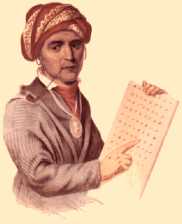Sequoyah
|
|

George Guess, Guest or Gist known as Sequoyah or Sikw‚'yǐ (ᏍᏏᏆᏱ) in Cherokee (c.1767 - July or August 1843) was a Cherokee silversmith who invented the Cherokee syllabary.
| Contents |
Birth and early life
The exact place and date of Sequoyah's birth are unknown, as no written record exists. Speculation and guess-work by historians place his birth at some point between 1760 and 1776. As for the location, speculation places it in either Tennessee, Georgia, North Carolina, Alabama or South Carolina. James Mooney, a prominent anthropologist and historian of the Cherokee people, quotes a cousin in saying that Sequoyah and his mother spent his early years in the village of Tuskegee in Tennessee.
The name Seqouyah or Sikw‚'yǐ is believed to be derived from the Cherokee word Sikwă meaning pig. Possibly this is a reference to a child-hood deformity or a later injury that left Sequoyah crippled. Again, scholars agree that he was crippled but the reason is disputed.
Of his mother, it is known that she was a Cherokee and belonged to the Paint Clan and Mooney states that she was the niece of a Cherokee chief. His father was either white or part white and part Native American. Again, sources differ as to the exact identity of Sequoyah's father, but many (including Mooney) suggest that he was possibly a fur trader or the son of Christopher Gist, a scout for George Washington.
There is some indication, however, that Sequoyah and his mother were abandoned by his father, this may be indicated by the fact that Sequoyah did not speak English. At some point before 1809, Seuqoyah moved to the Wills Valley in Alabama. There he established his trade as a silversmith. He may have fought in the Creek War between 1813 and 1814 against the Red Sticks. Of course if he was crippled, likely he would not have fought, but historians speculate that he may have been wounded in battle, thus leaving him crippled.
"Talking Leaves" and a syllabary
Cherokee-syllabary.jpg
As a silversmith, Sequoyah dealt regularly with white people who had settled in the area. Often, the Native Americans were impressed by their writing, referring to their correspondence as "talking leaves." Around 1809, Sequoyah began work to create a system of writing for the Cherokee language.
After attempting to create a character for each word, Sequoyah decided to divide each word into syllables and create a character for each syllable. Utilizing the Roman alphabet and quite possibly the Cyrillic alphabet, he created 85 characters to respresent the various syllables. This work would take Sequoyah 12 years to complete.
There was some doubt amongst his fellow Cherokee as to the worthiness of his alphabet. In order to prove his creation, Sequoyah taught his daughter Ah-yo-ka how to read and write in Cherokee. After amazing locals with his new writing, Sequoyah attempted to display his feat to tribal medicine men only to be rebuffed by them for being possessed by evil spirits. Sequoyah finally proved his feat to a gathering of Chickamaugan warriors. Quickly news of the syllabary spread and the Cherokee were filling schools in order to learn the new language. By 1823 the syllabary was in full use by the The Cherokee Nation (http://www.cherokee.org). The language was made the official language of the Cherokee Nation in 1825.
Life in Arkansas and further west
After the acceptance of his syllabary by the nation in 1825, Sequoyah moved to the new Cherokee territory in Arkansas. There he set up a blacksmith shop and a salt works. He continued to teach the syllabary to anyone who came to him. In 1828, Sequoyah journeyed to Washington, D.C. as part of a delegation to make a treaty for land in Oklahoma.
His trip brought him into contact with representatives from other tribes of Native Americans around the nation. With these meetings he decided to create a syllabary for universal use among all Native American tribes. With this in mind, Sequoyah began to journey to areas of present day Arizona and New Mexico seking tribes there.
In addition, Sequoyah dreamed to see the splintered Cherokee Nation (http://www.cherokee.org) re-united. It was on a trip seeking Cherokees who had moved to Mexico that he died in the summer of 1843.
Sequoyah's name
- The name of the district where Sequoyah had lived in Oklahoma was changed to Sequoyah District in 1851. When Oklahoma was admitted to the union, that area became known as Sequoyah County.
- The Sequoia tree is commonly believed to be named after him, but some botanists have challenged this claim.
- The proposed State of Sequoyah was named in his honor.
External links
- Invention of the Cherokee Alphabet (http://library.wcu.edu/CherokeePhoenix/Vol1/no24/pg2col1a-2a.htm) published in the Cherokee Phoenix
- The Life and Work of Sequoyah; Chronicles of Oklahoma (http://digital.library.okstate.edu/chronicles/v008/v008p149.html)
- The Father of Sequoyah: Nathaniel Gist; Chronicles of Oklahoma (http://digital.library.okstate.edu/Chronicles/v015/v015p003.html)
- Sequoyah (http://www.tiro.com/syllabics/Cherokee/Sequoyah.html) from Tiro Typeworks
- Sequoyah (aka George Gist), a North Georgia Notable (http://ngeorgia.com/people/sequoyah.html)
- The Cherokee Nation (http://www.cherokee.org)
- Cherokee Font (http://www.cherokee.org/Extras/DownloadsPage.asp?ID=4)da:Sequoyah
